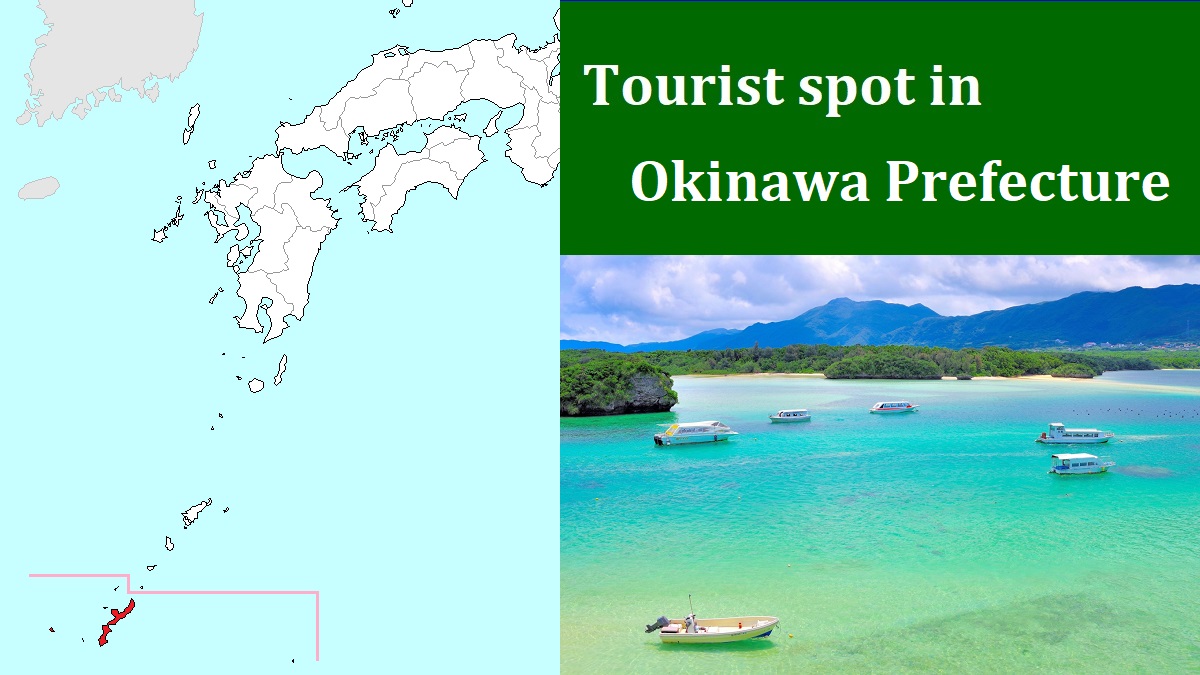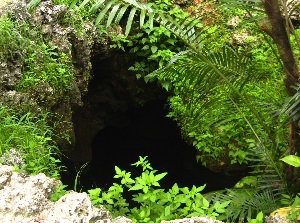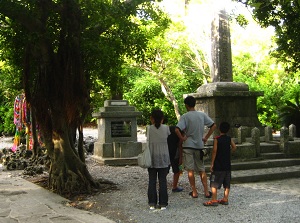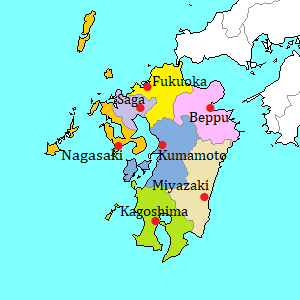Okinawa Senseki Quasi-National Park [沖縄戦跡国定公園]
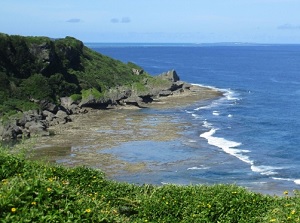
The coast around Mabuni Hill
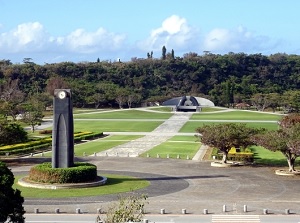
Okinawa Peace Memorial Park
Okinawa Senseki Quasi-National Park is the area at the southern edge of Okinawa Island.
It is located about 12 to 16 km south of Naha city and is in Itoman city.
There are some Okinawa Battle sites in this area.
Japanese army started the Pacific War (World War II) at bombing of Pearl Harbor in Hawaii on December 8, 1941.
Japanese army was strong, so the occupied territory spread from a lot of islands in the western Pacific Ocean to Southeast Asian countries which were the colonies by powerful countries of Western Europe such as Britain, France, the Netherlands.
But, Japanese army lost in the Battle of Midway Island in June 1942.
That turned the tide of the war.
In July 1944, Japanese army was lost in Saipan Island in the Northern Mariana Islands.
At last, Okinawa became the next target of the allied forces.
Japanese army sent over 116,000 soldiers to Okinawa Island.
Japanese army had planned to set the southern part of the island as the main battlefield.
So Okinawa residents were moved to the north part of the island.
But many residents were still in the southern part of the island due to insufficient order.
American troops started the attack to Okinawa on March 26, 1945.
They baffled the plan of Japanese army and landed at the mid-west coast of the island on April 1, and succeeded in dividing Japanese army.
Japan army held against them, but American troops were strong.
The military potential dropped away.
Many Okinawa residents in the southern area were involved in the fierce battle, so most of them were killed.
On June 13, the commander Oota Minoru was killed himself in Underground Headquarters near Naha city.
On June 23, another commander Ushijima Mitsuru killed himself in Mabuni Headquarters near the southern end of the island.
At last, the battle in Okinawa finished on the day and the allied forces occupied Okinawa.
In the same period, American troops had been carrying out air raids to over 400 cities and towns on the mainland of Japan including Tokyo, Osaka, Nagoya, Kyoto, Kobe.
Over 560,000 people were killed.
And, they dropped two A-bombs on Hiroshima city (August 6) and Nagasaki city (August 9).
On August 15, 1945, the long war ended with the unconditional surrender of Japan.
This battle involved a large number of Okinawa people, so it became one of the worst battles and the only ground battle in Japanese history.
In Okinawa, over 94,100 Japanese soliders and about 94,000 Okinawa residents died.
On the other hand, over 120,000 American soldiers died during this battle.
The southern area of Okinawa Island where the fierce battles were waged has been designated as a quasi-national park since 1965.
The area is about 10 km from east to west and about 5 km from north to south in width, and includes the sea around the coast.
Many cenotaphs are dotted in the hilly area with gentle undulations, and there are some peace memorial parks.
Every year, Okinawa Prefecture holds the memorial ceremony on June 23.
Peace Memorial Park (平和祈念公園)
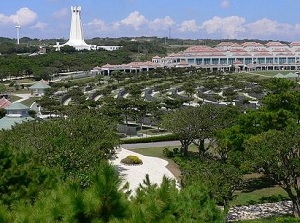
Peace Memorial Park in Mabuni
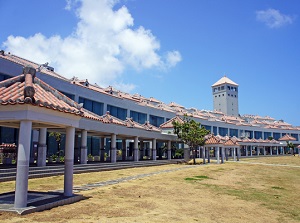
Okinawa Peace Memorial Museum
Peace memorial Park is the central park with many cenotaphs.
It is located on Mabuni Hill (摩文仁の丘) near southern coast of Okinawa Island.
On this hill, there was Mabuni Headquarters of Japan army.
The park is about 1 km from north to south and about 0.5 km from east to west.
Peace Memorial Museum (平和祈念資料館) is in the center of the park.
It introduces the Battle of Okinawa from the viewpoint of Okinawan residents.
Many articles and photos are displayed.
The words by many people who experienced the battle are shown.
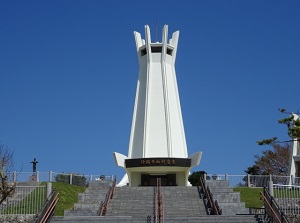
Okinawa Peace Hall
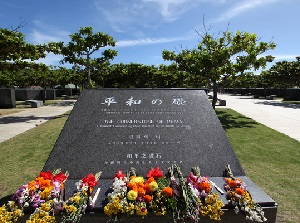
Cornerstone of Peace in Peace Memorial Park
Okinawa Peace Hall (沖縄平和祈念堂) is the hall 45 meters tall to the northwest of Peace Memorial Museum.
The shape is a heptagon and the statue for peace are set up in the hall.
Cornerstone of Peace (平和の礎, "Heiwa no Ishiji" in Japanese) is the central cenotaphs of the park.
There are many stones on which the names of victims of Okinawa Battle are inscribed.
Over 240,000 names have been inscribed on the stones.
They include not only Okinawan residents, Japanese soldiers but also American soldiers and the other foreigners such as Britain, Taiwan and Korea.
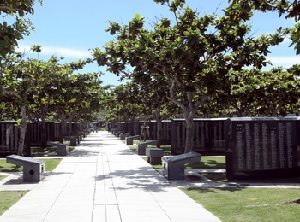
Stones of the names of victims in Heiwa no Ishiji
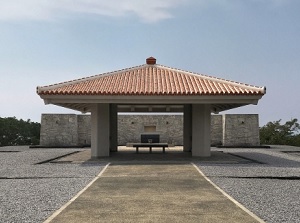
National Cemetery for the Okinawa Battle
National Cemetery for the Okinawa Battle (国立沖縄戦没者墓苑) is in the south part of the park.
It is the cemetery for the people who were killed by the Battle of Okinawa.
About 180,000 peoples' bones are laid to rest.
Around this cemetery, many other cenotaphs are set up.
Tower of Himeyuri (ひめゆりの塔)
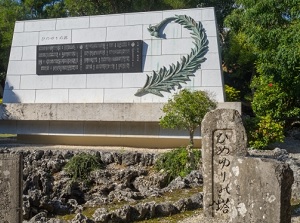
Himeyuri no Tou (right side)
and big cenotaph
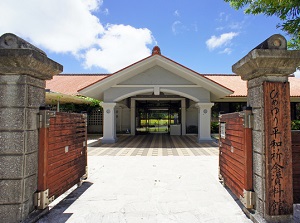
Museum of Himeyuri no Tou
Tower of Himeyuri ("Himeyuri no Tou" in Japanese) is the small stone tower located about 3.5 km west of Peace Memorial Park.
In March, 1945, 222 schoolgirls and 18 teachers of a high school joined Japanese army as the nurses in the army hospital near Naha.
The team was called "Himeyuri Gakutotai" (Star Lily Corps).
Because the attack by American troops became fierce, they escaped to the underground shelters close to the south coast in May.
Unfortunately, this area was in a heavy combat situation.
At last, Japanese army abandoned them in the confusion, so most of the young lives were the victims in the battle around the shelters.
Some surviving girls were cornered around coast, but they killed themselves there.
After the war, this tragic story was introduced in a novel and some movies, and many Japanese people knew the fact.
Many Japanese tourists visit here every day.
The tower was built around the underground shelters in 1946.
Later, a large cenotaph was built.
And there is the museum opened in 1989.
How to get here
By route bus, about 40 minutes from Naha terminal to Itoman terminal.
Change to the bus.
From Itoman terminal, about 15 minutes to Himeyuri-no-tou stop, about 25 minutes to Heiwa-Kinendo stop.

